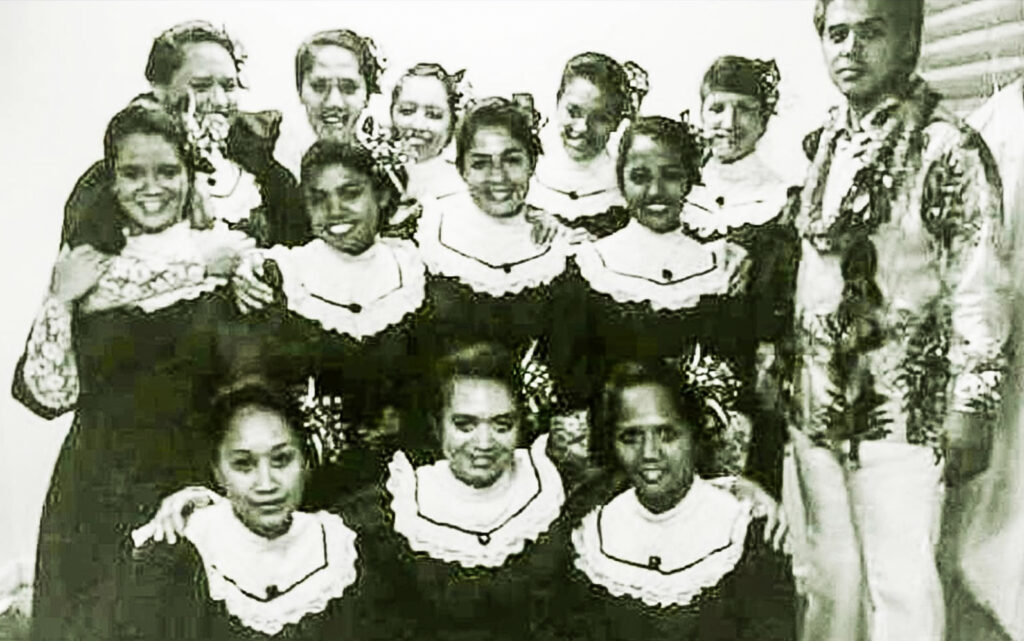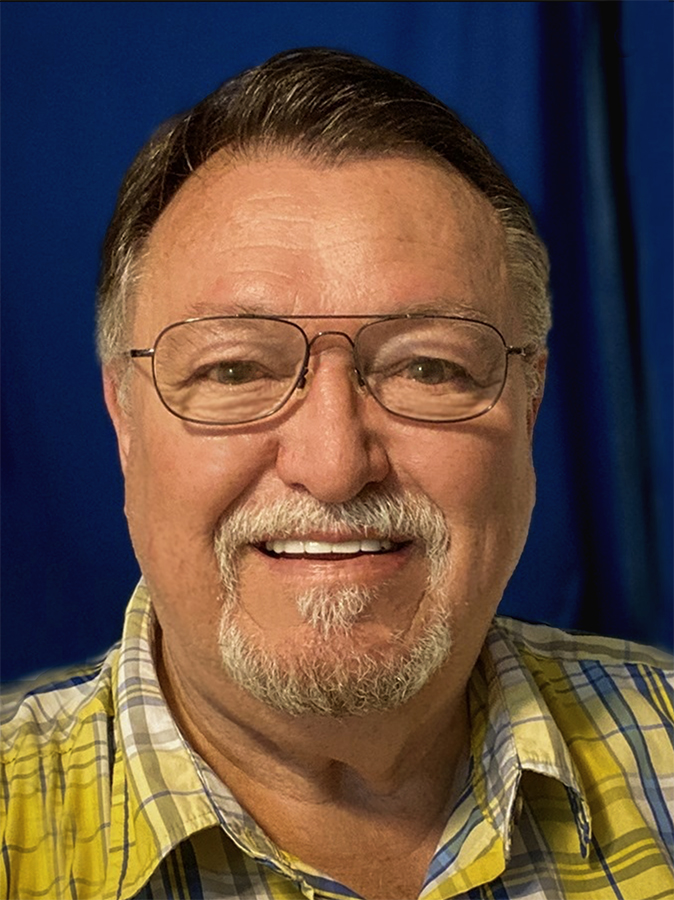Story and photo by Mike (Mikaele) Foley

On August 16, 2025, over 200 people formerly associated intermittently with the Polynesian Cultural Center’s own hālau hula over the past 40-plus years held a special reunion in Laie.
Some PCC alumni may not even be aware the Center not only had its own hālau hula, but that the group went on to perform widely and win awards in annual competitions such as the Merrie Monarch Festival in Hilo, the King Kamehameha Festival, and the Prince Lot Hula Festival.
In the early 1980s, the late part-Sāmoan William H. Cravens, then vice president and general manager of the Polynesian Cultural Center, wanted the PCC to showcase our vast talent pool beyond the grounds in various community and outside activities.
[● Historical note: While Cravens was the first Sāmoan general manager of the Center, Lawrence Haneberg — a Hawaiian businessman and member of the early board of directors — was actually the first Polynesian general manager for a brief time in the early years. Before he departed, Cravens — a descendant of the prominent Soliai family in American Sāmoa — became the first Polynesian president of the PCC in 1983.]
He asked four of the PCCs finest young kumu hula at the time — Cy Bridges, Keith Awai, and the late “Uncle Bill” Wallace III and Enoka Kaina — to start up our own hālau hula, which Kaina named Hui Ho‘oulu Aloha. A simple literal translation would read “group + fosters/develops +love,” but of course, Bridges explained their name much more artfully when he said, “sometimes when you translate the words, you lose the essence of it.”
The hālau included student PCC employees, alumni, and even a few who traveled long distances to participate. [● Historical note: Kaina passed away in 1993, and Uncle Bill Wallace died in 2009.]
“Of a certain age”: With some of the haumāna or “students” and two of the original kumu now of a certain age, Michelle Mata Drumwright, who danced with the group in the early 1990s, felt now was the right time to hold a reunion.
“We had at least 200 people come,” said Michelle, one of the prime organizers of the recent Hui Ho’oulu Aloha reunion. As she did then, Michelle was living in Rockland, California (near Sacramento), and worked for Hawaiian Airlines, which enabled her to commute to the various practices and performances. She even competed for the Miss Aloha Hula title in the 1991 Merri Monarch Festival.
“I had a dream of doing this, and when kumu hula Cy Bridges came into the room, we had his daughter, Maria Bridges, do an oli or welcoming chant for him. The spirit was so powerful. It was kind of like a homecoming, in a sense,” she said. “I was speechless. Some people even said it was kind of like a funeral where lots of old-timers get together, and even Kumu Cy joked, ʻWhat an awesome experience to attend my own funeral.ʻ“
“Keith Awai was also there, and of course, we also celebrated the other original kumu hula. Their families were there as well. The joy that we felt being with one another (2:03) again was just unbelievable.”
Michelle explained she was with the hālau for about three years from 1990–1992, and added under Kumu Cy’s direction, she competed for the Miss Aloha Hula title during the 1991 Merrie Monarch Festival in Hilo. She also came back on a number of other occasions, such as the annual Moanikeala Festival, which is now held in the Center’s Hawaiian Village.
Lots of impromptu hula: “Naturally, like many such hālau hula gatherings, lots of people were asked to get up and dance impromptu,” Michelle continued.”Kumu hula Frank Kawaikapu Hewett, was one. Keith Awaiʻs hālau, led by Faith Craycroft, was another, and about 10 members of Hula Hālau ʻO Kekela, under kumu hula Kela Miller also performed.”
“Uncle Harry Brown, one of the regular musicians for the hālau, came from Maui with his wife, Donna Conklin Brown: She was a regular kōkua for the group.”
In fact, Michelle explained that Brown, and the brothers from Keaukaha on the Big Island, Jay and Bobby Akoi — along with Matt Kalua‘ū and Zak Yalimaiwai — provided most of the music during the reunion; and, of course, the Bridges, Brown, and the Akoisa were known for many years as the “singing bishops,” because each of them at one time served as bishops of various Latter-day Saint congregations in the Laie/Hau‘ula area.
Remy Pascal-Primacio, one of the early hālau dancers, said, “We nicknamedthem the ʻMelazishes,ʻ a combination of melody and musicians, because they were that awesome.” Others who helped as musicians included Lamar Benavides and the late Greg Tata, a New Zealand Maori who also worked with the BYUH Showcase Hawaii group.
Michelle said a number of people asked if there would be another Hui Ho‘oulu Aloha reunion. She said she suspected this was a “one-of-a-kind thing,” but Uncle Jay Akoi posted on the Facebook group, “just let them know when the next reunion was, and as long as they could still walk and sing, the ʻbishopsʻ would be ready to go again.”
Kela Miller, one of Uncle Cy’s alaka‘i (or leaders) who now has her own hālau hula, pointed out that Eddie Aina came from the Big Island for the Reunion, and Lincoln Uhi, a Tongan student, came from the U.S. mainland. She also recognized there was a memorial display of pictures set up during the reunion to honor group members who have passed away, including Kaleo Requilman, Pualoke Dela Cerna and her son.
“Pualoke taught a lot of the dancers how to make their leis. I talked story about old Ko‘olauloa; and we also pulled together a fireside presentation where Cy shared about the hālau and the different connections we had to other kumu and all the songs and dances we learned,” Kela continued. “Sharing all these things was just a precious time for us.”
Michelle recognized Jerusha Wallace Magalei, and some of her kids came to represent “Uncle Bill” Wallace, while Alohalani Houseman from BYU–Hawaii, Kumu Enoka Kainas’ ex-wife, and several of her kids came and shared a hula.
“And Maria Bridges did a number dedicated to her mom and dad — the song that Kumu Cy wrote for his daughter, Sarah Bridges” (who died in an auto accident in 2000).
Crossing paths with so many others: Kela s;paid tribute to all the early CCH and BYUH students, especially those from the South Pacific and Asia, who gained so much from their experiences in Laie while sharing their talents with us.
“I thank my heavenly father for the opportunities we had to cross one another’s path with my hula brothers and sisters and reconnect again,” Michelleresponded. “Some of us never met before because they were in the eighties or early 1990s.
Kumu Cy Bridges responds: “I give credit to Michelle and all her team that put the reunion together,” he said. “It was an absolutely awesome night”
Meanwhile, author Mike Foley recalled that the modern iteration of Hui Ho‘oulu Aloha performed during several Moanikeala Hula Festivals in the PCC’s Hawaiian Village, and also danced a special number composed by Krueger in tribute to the 2019 centennial of the Laie Hawaii Temple in the Hawaiian Journey Theater.
Tagaloataoa Delsa Atoa Moe, PCC vice president of cultural presentations, also recently commented that Hui Ho‘oulu Aloha was revived in the 2010s when Pōmaika‘i Krueger was the Center’s kumu hula and performed publicly under his direction.
“Hui Ho‘oulu Aloha went into hiatus during the Centers’ COVID-19 closing, and it may be revived again. “However, it may be revived again when the Center has more resources,” she added.

Your comment has been submitted for administrator approval.
Your comment was not saved. Please try again.
No comments yet.